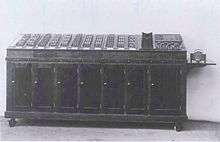Mallock machine

Mallock machine, 1933
The Mallock machine was an electrical analog computer built in 1933 to solve simultaneous linear differential equations. It used coupled transformers, with numbers of turns digitally set up to +/-1000 and solved sets of up to 10 linear differential equations. It was built by Rawlyn Richard Manconchy Mallock of Cambridge University. The Mallock machine was contemporary with the mechanical differential analyser, which was also used at Cambridge during the late 1930s and 1940s.
References
- R. R. M. Mallock. An Electrical Calculating Machine. Proceedings of the Royal Society of London. Series A, Containing Papers of a Mathematical and Physical Character 1933, 140 457-483.
- Bernard S. Finn. Exposing Electronics. NMSI Trading, 2002. ISBN 1-900747-48-0. Pages 64–73.
- Wilkes, M. V. A Method of Solving Second Order Simultaneous Linear Differential Equations using the Mallock Machine. Proc. Camb. Phil. Soc. 1940, 36, 2094.
- Croarken, M. G. The emergence of computing science research and teaching at Cambridge, 1936-49. Annals of the History of Computing, IEEE, 1992, 14, 10-15.
- http://www.cl.cam.ac.uk/Relics/chron.html
This article is issued from Wikipedia - version of the 5/8/2012. The text is available under the Creative Commons Attribution/Share Alike but additional terms may apply for the media files.